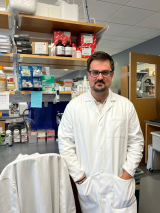Unraveling GABAergic interneuron-like lineage in H3G34-mutant hemispheric high-grade gliomas: their impact on network formation and invasion

Brain tumors are a major cause of cancer-related deaths in children, with high-grade gliomas (HGG) being particularly lethal. These tumors often have mutations in histone genes, occurring in a specific pattern during childhood development. Our research focuses on a subset called DHG-H3G34, marked by H3G34RV mutations. Our initial data reveal that these tumors have a cell population resembling interneurons in the brain, with altered gene expression and communication patterns. In experiments, DHG-H3G34 cells exhibited features associated with tumor invasion and resistance. In mice, these cells spread to distant brain regions, mirroring neuron migration in normal development. Our drug experiments suggest that a combination of inhibitors can reduce cell proliferation. Our study aims to, (1) map the spatial arrangement of these glioma cells, understanding how their communication networks and electrical activity promote tumor growth; (2) identify the migratory pattern of these cells within the brain; and (3) evaluate the effectiveness of a drug combination in reducing tumor growth in mouse models. This research addresses two challenges: understanding the biology of DHG-H3G34 tumors and revolutionizing treatment for children. By uncovering the unique features of this glioma subtype, we hope to pave the way for targeted treatments. Our approach shifts from traditional cytotoxic agents to precision medicine, tailored to the molecular profiles of DHG-H3G34 tumors.
Project Goal:
1) Analyze interneuron-like glioma cells in DHG-H3G34-mutant tumors to understand their spatial distribution, communication networks, and electrical activity, exploring their role in promoting tumor growth. 2) Investigate the invasive ability of glioma cells inside the mouse brain by monitoring preferred invasion routes in real-time to identify their movements within the parenchyma. 3) Assess the impact of a new dual combinatorial treatment strategy targeting proliferation and communication of tumor cells. I believe that by using compounds that block proliferation and communication (feature involved in cell migration) of glioma cells, I can stop the growth and reduce the invasiveness of DHG-H3G34-mutant tumors. My research focuses on finding weaknesses in a specific glioma subtype called DHG-H3G34. If successful, this could lead to new and effective ways to treat the disease it causes, which is fatal illness.

